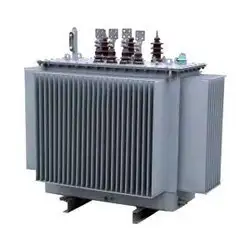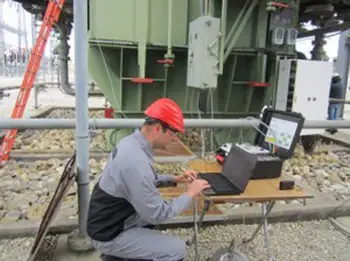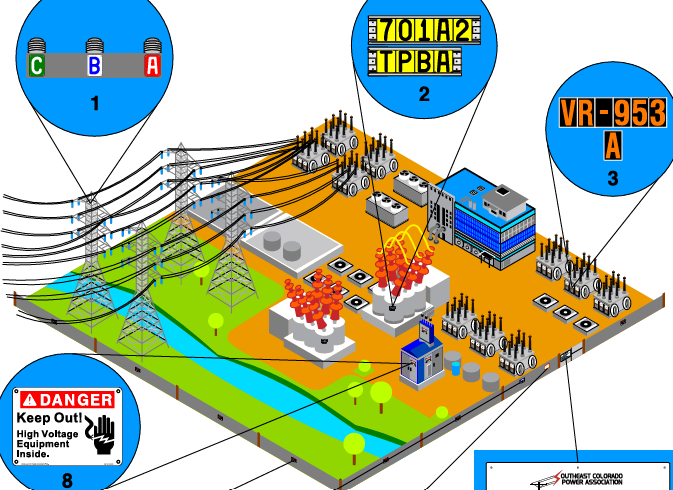Dry Type Transformers
By R. W. Hurst, President, The Electricity Forum

Substation Maintenance Training
Our customized live online or in‑person group training can be delivered to your staff at your location.

- Live Online
- 12 hours Instructor-led
- Group Training Available
Download Our OSHA 4475 Fact Sheet – Being Aware of Arc Flash Hazards

- Identify root causes of arc flash incidents and contributing conditions
- Apply prevention strategies including LOTO, PPE, and testing protocols
- Understand OSHA requirements for training and equipment maintenance
Dry type transformers provide safe, efficient, and reliable electrical power distribution without the use of liquid insulation. Commonly employed in industrial, commercial, and residential systems, they reduce fire risk, require minimal maintenance.
What are Dry Type Transformers?
Dry type transformers are electrical devices that use air or solid insulation instead of liquid coolant to transfer energy safely and efficiently.
✅ Safe operation with minimal fire risk
✅ Reliable performance for industrial and commercial use
✅ Eco-friendly alternative to oil-filled transformers
Electrical Transformer Maintenance Training
Substation Maintenance Training
Request a Free Training Quotation
These transformers either step up voltage to higher levels or step down voltage for end-use distribution. In practice, they commonly reduce transmission voltages (for example, 500 kV) to distribution levels (30 kV for industrial systems or 120–240 V for residential loads). Because no flammable liquids are involved, they are ideally suited for indoor environments where oil-filled units would pose safety concerns.
The term “dry type” refers to a cooling system that utilizes natural or forced air circulation. No oil, silicone, or other dielectric fluid is used to cool the core and coils. This design minimizes environmental hazards, simplifies installation, and virtually eliminates the risk of fire.
Kinds of Dry Type Transformers
Dry type transformers are manufactured in a wide range of designs to suit different applications:
-
Ventilated general-purpose: The most common, using air circulation for cooling.
-
Cast resin (epoxy encapsulated): Coils fully encapsulated in resin, providing strong moisture resistance and mechanical strength — ideal for harsh or corrosive environments.
-
VPI (Vacuum Pressure Impregnated): Windings impregnated with varnish under vacuum pressure, providing improved protection against moisture and contaminants.
-
Encapsulated/potted: Entirely sealed to protect from dust, dirt, and corrosive chemicals.
-
Specialty types: Drive duty, rectifier duty, K-rated for nonlinear loads, zig-zag for grounding, or computer-isolated kinds for sensitive electronics.
By selecting the appropriate version, engineers can tailor insulation strength, environmental protection, and load characteristics to meet specific application needs. Learn how Control Transformers regulate voltage in sensitive control circuits.
Electricity Today T&D Magazine Subscribe for FREE

- Timely insights from industry experts
- Practical solutions T&D engineers
- Free access to every issue
Table 1: Dry vs. Oil-Filled Transformers
| Feature | Dry Type Transformers | Oil-Filled Transformers |
|---|---|---|
| Cooling Method | Air or solid insulation (natural or forced air) | Mineral oil, silicone, or other liquid dielectric |
| Fire Safety | Very low fire risk | Higher fire hazard; requires fire vaults/containment |
| Environmental Impact | Eco-friendly, no liquid leaks | Oil leaks can contaminate soil/water |
| Installation | Suitable for indoor spaces (hospitals, schools, high-rise buildings) | Typically outdoor or in fireproof vaults |
| Maintenance | Low; mainly cleaning and inspections | Higher; requires oil testing, leak monitoring |
| Efficiency | Slightly lower at higher ratings | Generally higher efficiency in large units |
| Cost | Higher upfront, lower lifecycle costs in many cases | Lower upfront but higher safety/maintenance costs |
| Applications | Hospitals, tunnels, data centers, residential buildings | Substations, utility distribution, outdoor industrial plants |
Insulation and Thermal Design
Dry type transformers use high-temperature insulation systems—typically rated at 155 °C, 180 °C, or 220 °C, that determine allowable temperature rise and service life. For instance, a Class 220 transformer operating at reduced temperature rise can last decades with minimal degradation. Proper thermal design accounts for hot-spot temperature to prevent insulation breakdown. Explore the role of Current Transformers in monitoring and metering electrical systems.
Enclosures and Noise Considerations
Enclosures protect the transformer from environmental hazards. Options include:
-
NEMA 1 (indoor, general purpose)
-
NEMA 2/3R (moisture-resistant or rainproof for outdoor use)
-
NEMA 4/4X (watertight or corrosion-resistant for industrial and marine settings)
Dry type transformers may also be built with IP-rated enclosures for international use. Noise levels are another factor, particularly for hospitals, schools, or offices. Designs often incorporate sound-dampening features to meet acoustic requirements. Learn how Isolation Transformers enhance safety and minimize electrical noise in critical installations.
Standards and Codes
Dry type transformers are governed by multiple standards:
-
IEEE C57 series for design and testing
-
IEC 60076 international standards
-
CSA and UL certifications in North America
-
NEC (U.S.) and Canadian Electrical Code requirements for clearances, ventilation, and fire safety
Meeting these standards ensures compliance, safety, and reliable operation across a wide range of applications. For engineers selecting equipment, our Transformer Sizing resource provides practical guidance on choosing the right rating for specific applications.
Maintenance and Reliability
While dry type transformers are low-maintenance compared to oil-filled units, preventive practices extend their life:
-
Routine cleaning to remove dust and debris
-
Insulation resistance testing and dielectric testing to monitor the condition
-
Temperature monitoring to detect hot spots
-
Moisture control in humid environments
Failure modes often include insulation breakdown due to overheating or contamination. With proper care, they typically achieve lifespans of 20 to 30 years or more.
Space, Weight, and Installation
Dry type transformers are generally heavier and bulkier than oil-filled equivalents, yet they eliminate the need for fireproof vaults, containment basins, and venting systems. Installation planning must consider ambient temperature, altitude, ventilation, and acoustic limits. Because they can be located closer to load centers, they reduce voltage drop and improve system efficiency. Our article on Step Down Transformers explains how high transmission voltages are converted to usable levels for homes and businesses.
Performance vs. Cost
While initial costs and high-capacity losses may be slightly greater than oil-filled units, dry type transformers offer savings through reduced maintenance, simplified installation, and elimination of fire-safety infrastructure. Over their operational life, they often deliver a lower total cost of ownership, especially in urban and indoor environments.
Table 2: Comparison of Dry Type Transformer Subtypes
| Type | Cooling / Insulation | Best Applications | Pros | Cons |
|---|---|---|---|---|
| Ventilated | Air-cooled, open core/coil design | General-purpose indoor use | Simple, cost-effective, widely available | Sensitive to dust, moisture |
| Cast Resin | Epoxy resin encapsulated windings | Hospitals, tunnels, offshore, corrosive environments | High fire resistance, moisture-proof, robust | Higher cost, heavier |
| VPI (Vacuum Pressure Impregnated) | Windings sealed with varnish under vacuum | Industrial, commercial, outdoor under shelter | Good moisture resistance, durable, cost-effective | Less robust than cast resin in harsh conditions |
| Encapsulated / Potted | Fully sealed with resin | Outdoor, chemical plants, dusty areas | Excellent protection from contaminants | Limited power rating, heavier |
Real-World Applications
These kinds of transformers are widely used in environments where safety and reliability are critical:
-
Hospitals and medical centers (low noise, fire-safe)
-
High-rise and residential complexes (indoor placement)
-
Tunnels and subways (fire-resistant cast resin)
-
Data centers and schools (low maintenance, dependable)
-
Industrial facilities such as steel, chemical, and mining plants (sealed against contaminants)
These examples highlight their versatility and increasing adoption worldwide. To understand energy performance, review Transformer Losses and how they impact system efficiency.
Market and Innovation Trends
Growing emphasis on sustainability, fire safety, and renewable integration is driving significant innovation in dry type transformer technology. Manufacturers are developing advanced epoxy insulation systems, IoT-enabled temperature monitoring, and higher-efficiency magnetic cores. These improvements position dry type transformers as key components of next-generation, low-emission power infrastructure across North America and beyond.
Choosing the Right Dry Type Transformer
When selecting a dry type transformer, consider:
-
kVA rating and application load profile
-
Primary/secondary voltage and BIL (Basic Insulation Level)
-
Insulation class and temperature rise
-
Enclosure rating (NEMA/IP) for the environment
-
Efficiency rating and expected lifetime costs
-
Compliance with IEEE, IEC, CSA, UL, and NEC standards
Asking these questions ensures the right balance of safety, performance, and cost efficiency for your project.
Sign Up for Electricity Forum’s Electrical Transformers Newsletter
Stay informed with our FREE Electrical Transformers Newsletter — get the latest news, breakthrough technologies, and expert insights, delivered straight to your inbox.
Related Articles
Explore more transformer resources to complement your understanding of dry type transformer design and operation:
-
Learn about general Electrical Transformers and how they form the foundation of every power distribution system.
-
Review our detailed guide on Dry Type Transformer Types to compare cast resin, VPI, and VPE designs.
-
Discover how Instrument Transformers enhance accuracy in metering and protection circuits.
-
Understand how Transformer Testing ensures reliability, safety, and code compliance.
-
For foundational knowledge, read What Is a Transformer? for a complete overview of transformer theory and operation.








